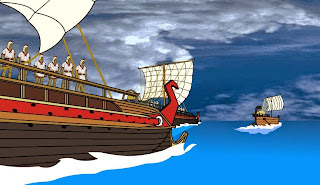I have finally tracked down a picture of the possible Carthaginian helmet found at the site of the naval Battle of Egadi 241BC - fought off the island of Levanzo off the western coast of Sicily.
 |
| Basemap from RPMN |
The battle site has yielded numerous Montefortino helmets, presumably worn by the Roman combatants.
Then a different helmet was retrieved...
First described as 'conical' and with a nose-guard and broad neck-gaurd, this helmet was thought to be a Carthaginian officer's helmet because it was so different from the 'Roman' ones.
Looking at the photo, which is from
Current World Archaeology issue 65 the first thought is of Thraco--Makedonian helmetsfamiliar from the Alexander sarcophagous and many examples sitting in museums.
There appears to be a cut-out for the ear in the middle of the picture. Maybe the back of the helmet is at the left.
 |
| Alexandrian hypaspist in colour |
There is a flared brim around a carefully raised bowl. This is not a mass-produced item like the pot-like Montefortino helmets.
There appears to be a high Phrygian crest which is damaged.
 |
| From Danish National Museum |
Evidence for a nasal is hard to see in the photo. Thraco-Makedonian helmets did not necessarily have them.
 |
| Etruscan cinerary urn showing Oedopus' sons in combat |
There was also a Boeotian-Phrygian helmet which would also be a candidate.
 |
| From Rome at war website |
These types of helmets with brims for protection but good hearing and visibility would be ideal for use at sea where footing was insecure and fighting could go on in very confused conditions.
Prog. Andrew Goldman of the Egadi Project has stated the helmet is 'without parallel' and may be the 'first example of Carthaginian armour yet found'.








